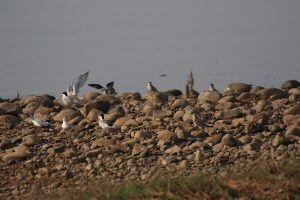Waders flock to Hirakud for nesting

Bhubaneswar/Sambalpur: Hirakud wetland has turned into an important breeding ground this summer, as thousands of migratory waders (commonly called shorebirds or water birds) — including Terns, Pratincoles, and other waders — laid eggs at approximately 26 islands, scattered across the region for nesting. More than ten species of waterbirds, such as River Terns, Gull-billed Terns, Little Terns, Oriental and Little Pratincoles, Little Ringed Plovers, Whiskered Terns, and several varieties of egrets have been observed laying eggs and nurturing their chicks. Large breeding colonies of River Terns and Pratincoles are sighted on some islands. Mothers tirelessly guard eggs and hatchlings, and juveniles from the scorching summer heat, engaging in post-fledging care throughout the day. The islands, which emerge from the receding waters of the Hirakud reservoir in April, offer ideal conditions— isolation from predators, no human intervention, and an abundant fish supply. Although five Indian Skimmers— an IUCN Endangered species- have been spotted among the flocks. But any nesting activity or sight is yet to be confirmed.
To protect the breeding sites and prevent disturbances, authorities from Debrigarh Wildlife Sanctuary have taken proactive steps. Over 100 red flags have been placed across nesting islands to alert fishermen and raise awareness among the villages residing in nearby areas adjacent to the islands. A dedicated ‘river patrol team’ has been formed to ensure constant surveillance, while tourist boats are kept at bay, as their approach can likely cause birds to abandon nests, leaving eggs and chicks exposed to heat and predators, said Hirakud Wildlife Division Divisional Forest Officer (DFO) Anshu Pragyan Das. The birds build shallow, camouflaged nests directly on sandy or rocky ground. The eggs and chicks blend so well into the landscape, get camouflaged, and become nearly invisible to the human eye. The average gestation period for these birds ranges from 20 to 30 days, with incubation lasting 7 to 25 days. Mating, nesting, and chick-rearing began in April and is expected to continue over the next few months. Shorebirds are among the most threatened bird groups, often preyed upon by stray dogs, snakes, raptors, and other predators. The Hirakud islands offer a rare sanctuary, distanced from human activity, livestock, and land predators such as jackals, hyenas, wild dogs, and wolves from Debrigarh Wildlife Sanctuary and the adjacent shoreline. To bolster conservation efforts, a team comprising 9 squads, 4 frontline staff, and 2 speedboats has been trained to monitor bird behaviour and nesting patterns. ‘Chadhei Club’ members from Sambalpur have also been instrumental in identifying nesting sites within human-influenced zones of the wetland and promoting their protection, according to Das. A water bird census conducted January 18, recorded 3.77 lakh migratory birds across the entire Hirakud Wetland — an increase of 35,000 from 2024. This growing population reaffirms the ecological significance of Hirakud, a designated Ramsar Site by the Ministry of Environment, Forest and Climate Change in 2022.
News